The Black-winged Stilt
First published in Sanctuary Asia,
Vol. 43
No. 11,
November 2023
Text and photographs by Dr. E. Bharucha
Somehow, in the process of saving rare and endangered species, the common (and therefore perhaps, more critical) life forms tend to be forgotten by many. These birds form an indispensable part of the same ecological set-up in which the rare creatures live, frequently, in fact, constituting the supporting ribs of the fragile ecological web.
All too often bird-watchers on the waterfront are obsessed with their search for unusual species which serves merely to frustrate their lives as Pink-headed ducks or Jerdon's Coursers are unlikely to be found irrespective of how hard the legions of bird-watchers try. If only these adventurous souls could discover the joys of observing the habits of several of our commoner birds, they would soon uncover some fascinating aspects of their lives which are still shrouded in mystery.
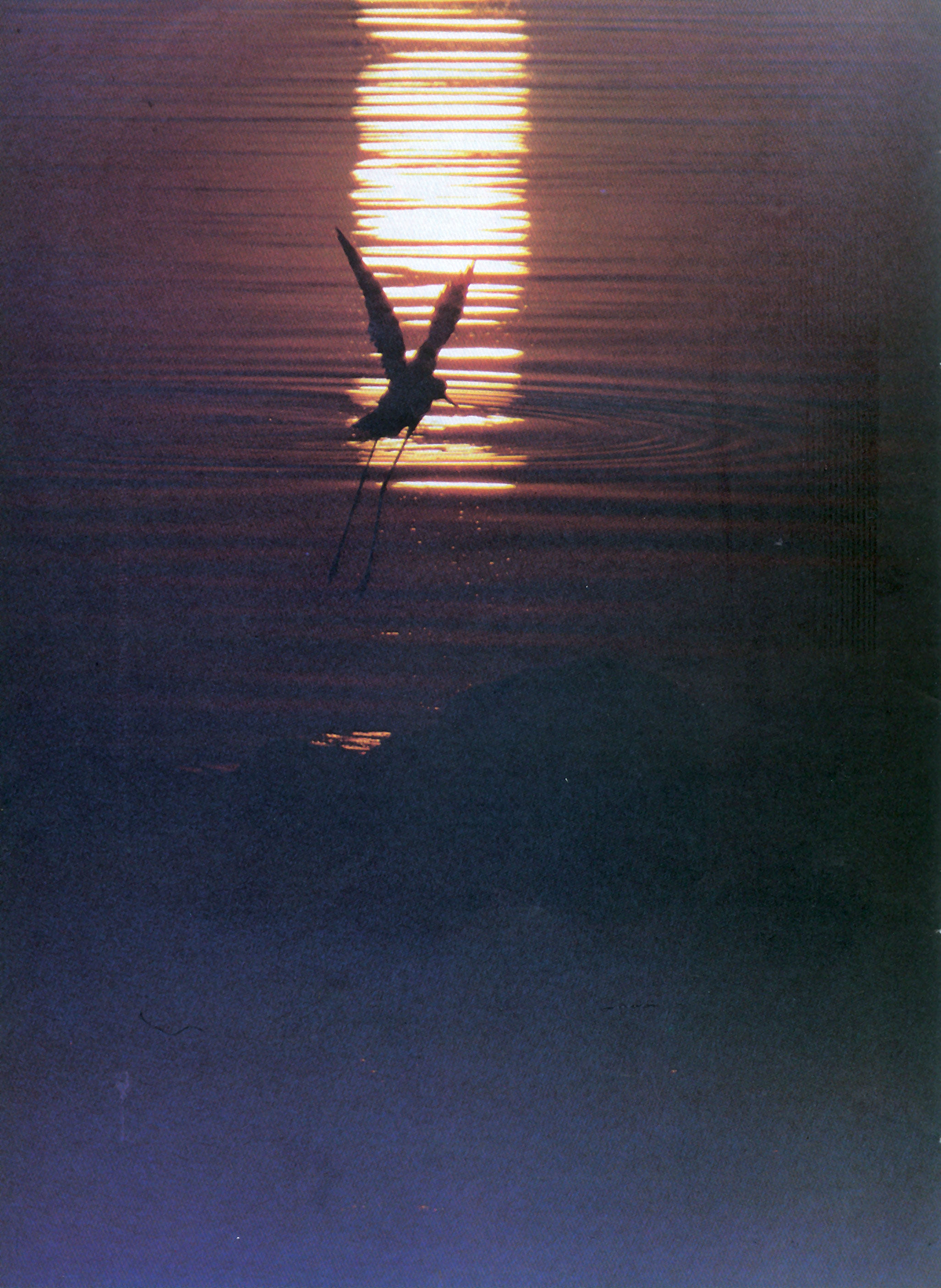
As a pale winter sun rises over the river, a graceful black and white wader moves around in the pink mist over the water. Calling loudly it wanders about in the shallow water looking for a place in which to feed. As the sky begins to brighten, the dominant birds start hustling the weaker ones to establish the pecking order for the day. Only now does the serious business of hunting for food start.
The Black-winged stilt (Himantopus himantopus) is one of the most fascinating waders seen on the banks of the many water-bodies in our country. Proportionately the longest legged of the waders, with the exception of the flamingo, the tall, lanky, slender-necked, Blackwinged stilt presents a stark visual contrast. Its black wings and white neck and underparts give it the distinctive look of a formally dressed dinner guest! The bright red legs and red iris provide an added dash of colour. In winter both sexes are fairly similar in appearance with dabs of greyish-brown on their heads and necks. The sooty-brown wings of the female are, however, duller than those of the male, which have an added metallic, blue-green sheen. With the onset of summer the adult male sports darker spots on his head extending down to his neck.
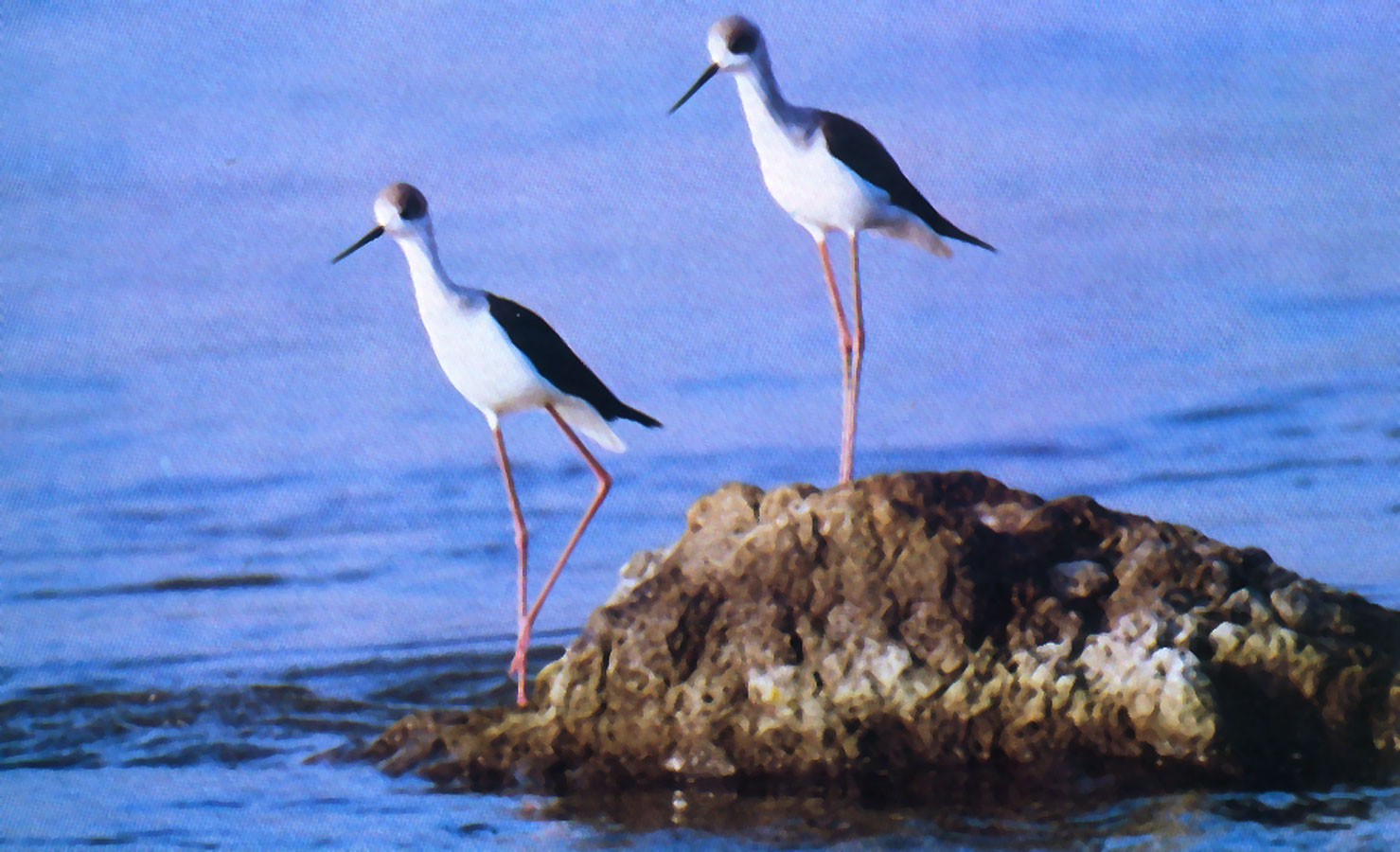
Members of the genus Himantopus, are a very variable species, (upto eight are recognised) of which the Black-winged is one. They have an extremely broad breeding range, from temperate to tropical climates and from rain forests to deserts, spreading over Eurasia, Africa, Australia and the Americas. Most members of this family are, however, nomadic, moving as conditions change, with a few northern hemisphere populations migrating over short distances.
The Black-winged stilt is both a resident and a visitor in India. Every winter it makes its way south in small flocks and settles on the edges of marshes, lakes, rivers and tidal areas all over the Indian peninsula. In summer these flocks move northwards again, to nest in the lakes and rivers of northern India, north-west Pakistan and Afghanistan.
A masterpiece of evolution, the Black-winged stilt fits perfectly into a special eco-niche in the shallows which few other waders have managed to exploit as successfully. This eco-niche consists of reasonably clear water, rich in aquatic life, ranging in depth from four to twelve inches. At this depth its long wading legs give the stilt an edge over most other waders like sandpipers and the diminutive stints, allowing them to explore comparatively deeper areas thereby reducing competition, by providing a wider feeding zone. Interestingly, in this feeding zone, most ducks too find themselves `out of their depth' as the area is too shallow for them to `upend' easily. This small, specific area is, therefore, almost exclusively the preserve of the stilt.
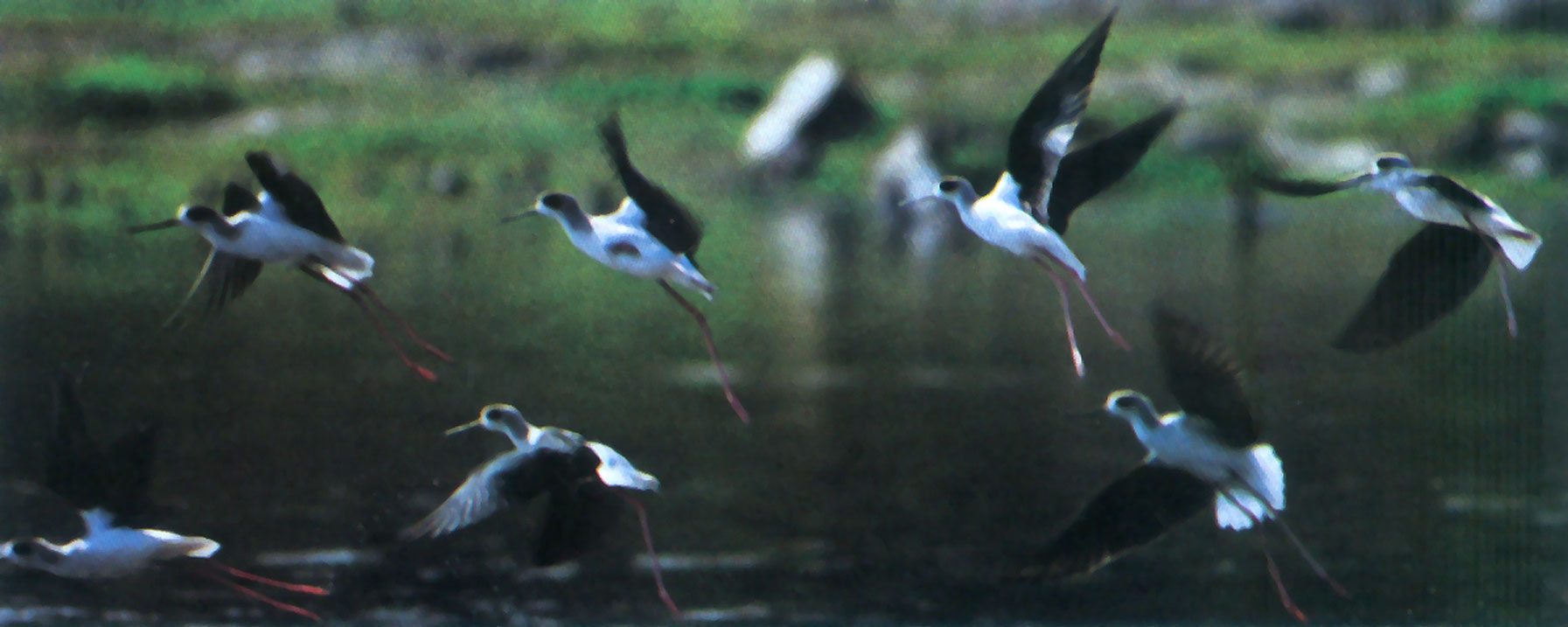
The stilt's legs dangle gracefully under its body in flight. Interestingly, the bird lowers or raises them as the need arises, using them to adjust its air-speed and also as a `rudder'.
The stilt's remarkable legs, almost ten inches long, are usually stretched neatly out behind the bird when flying, though for short hops they merely dangle about. Much to my amusement I discovered that the bird, despite the awkward length of its legs is still able to scratch its head with one foot outstretched over a wing. While flying the stilt must use a fairly rapid wing-beat and interestingly, it adjusts its air-speed by raising or lowering its legs, which are also used as rudders of sorts. To land, the bird glides gracefully downwards, wings held horizontally, and pushes its legs forward at the very last moment to come to a running or hopping halt. While observing flocks of stilts, their acrobatic techniques provide considerable entertainment. I have occasionally seen a bird drop its legs in the air, hover above the ground like an aircraft and then descend vertically on both feet. No less fascinating is the manner in which the delicate wader moves along the shoreline. It proceeds through the water with a jerky, high-stepping gait, lifting each leg well out of the water by bending its knee at right angles, before placing the foot gingerly down again in front.
The bill of the stilt is long thin and straight and is ideal for jabbing and pecking at food in the water, when the water is especially clear or its submerged prey particularly abundant. Or it may use a semi-scythe-like technique to uncover prey. Rapid currents, which bring food down-stream to be deposited in eddies, are favourite feeding grounds of the stilt. Occasionally one may also see the birds line up across the current, facing upstream, to make quick stabs at the food as it flows by, a bird or two sometimes even immersing itself neck-deep in its enthusiasm to grab a morsel. In areas where the current is sluggish the birds still get by rather well as molluscs, worms, insects, seeds and certain plants tend to settle at the bottom, providing adequate sustenance for the birds which congregate in large numbers in the shallows. A bird getting too close to the dominant member of the flock, however, risks getting a sharp jab to remind him to keep his distance!
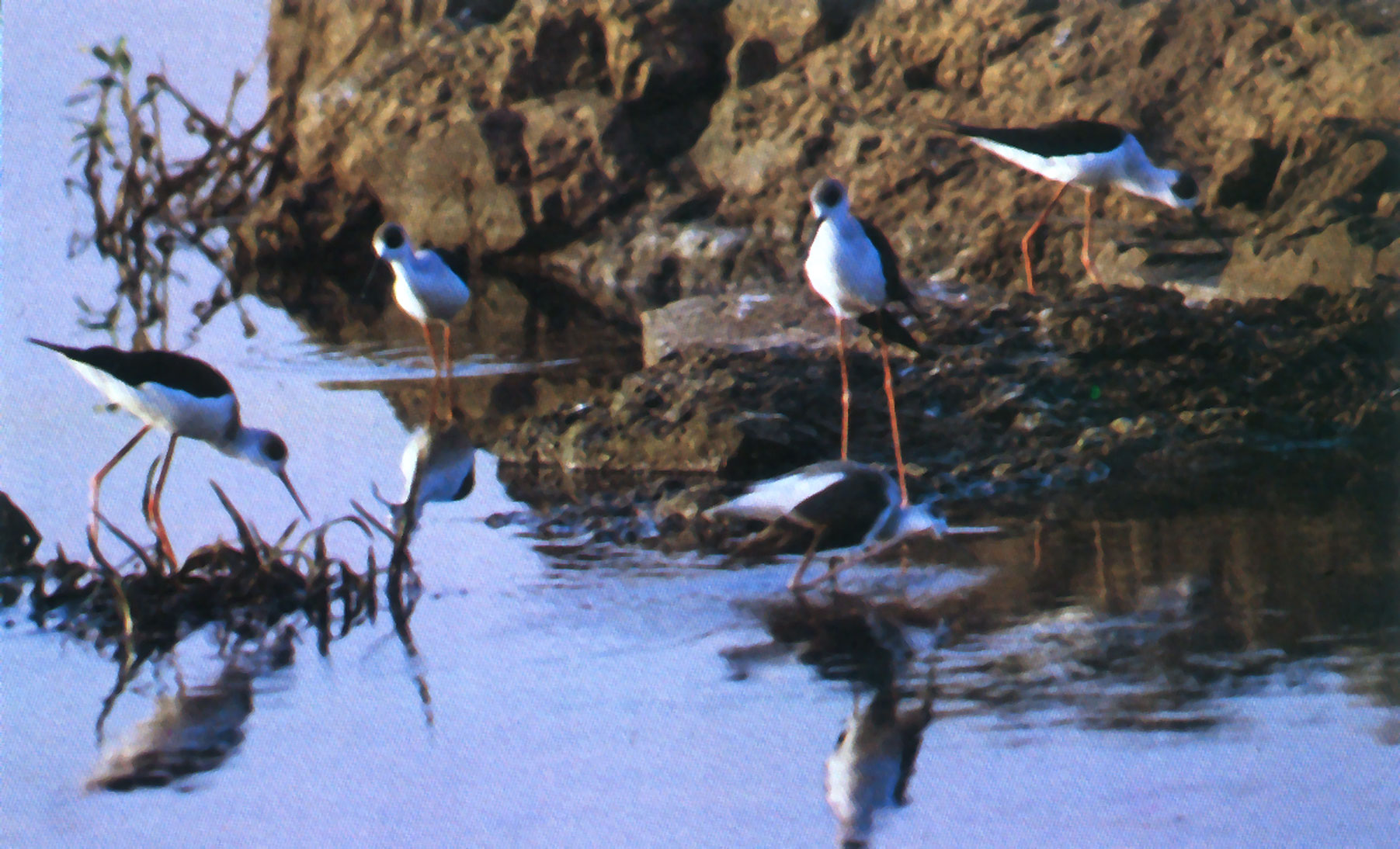
The Black-winged stilt (Himantopus himantopus) fits perfectly into its own special eco-niche in the shallows. Enormously long legs enable it to wade in fairly deep waters, which it explores for food by probing, plunging or jabbing at its prey.
Stilt flocks normally number between 20 to 100 individuals. Their shrill piping calls, feeble flapping flight and distinctive flight silhouette make them easy to identify even at a considerable distance. The birds assume a loose social bond within the flock and usually come together to roost in a safe place at night. They spend the day actively hunting for food singly, in pairs, in small parties or at times in large flocks. They settle in water up to their shanks and wade jerkily, zig-zagging through the hunting area and combing it completely before flying off to a new one. Unlike other waders and ducks, stilts only take brief rests from their feeding activities to preen themselves. Prolonged examples of preening and bathing have, however, been observed in female stilts -- in some cases the ritual even extending upto nine minutes!
When threatened, stilts assume an extremely tall and slim posture or they may aggressively hover over an opponent, legs dangling. They are fairly territorial especially when defending the area around their nests and can feign grievous injury (when their young are threatened) in order to lure a potential predator away from nesting chicks.
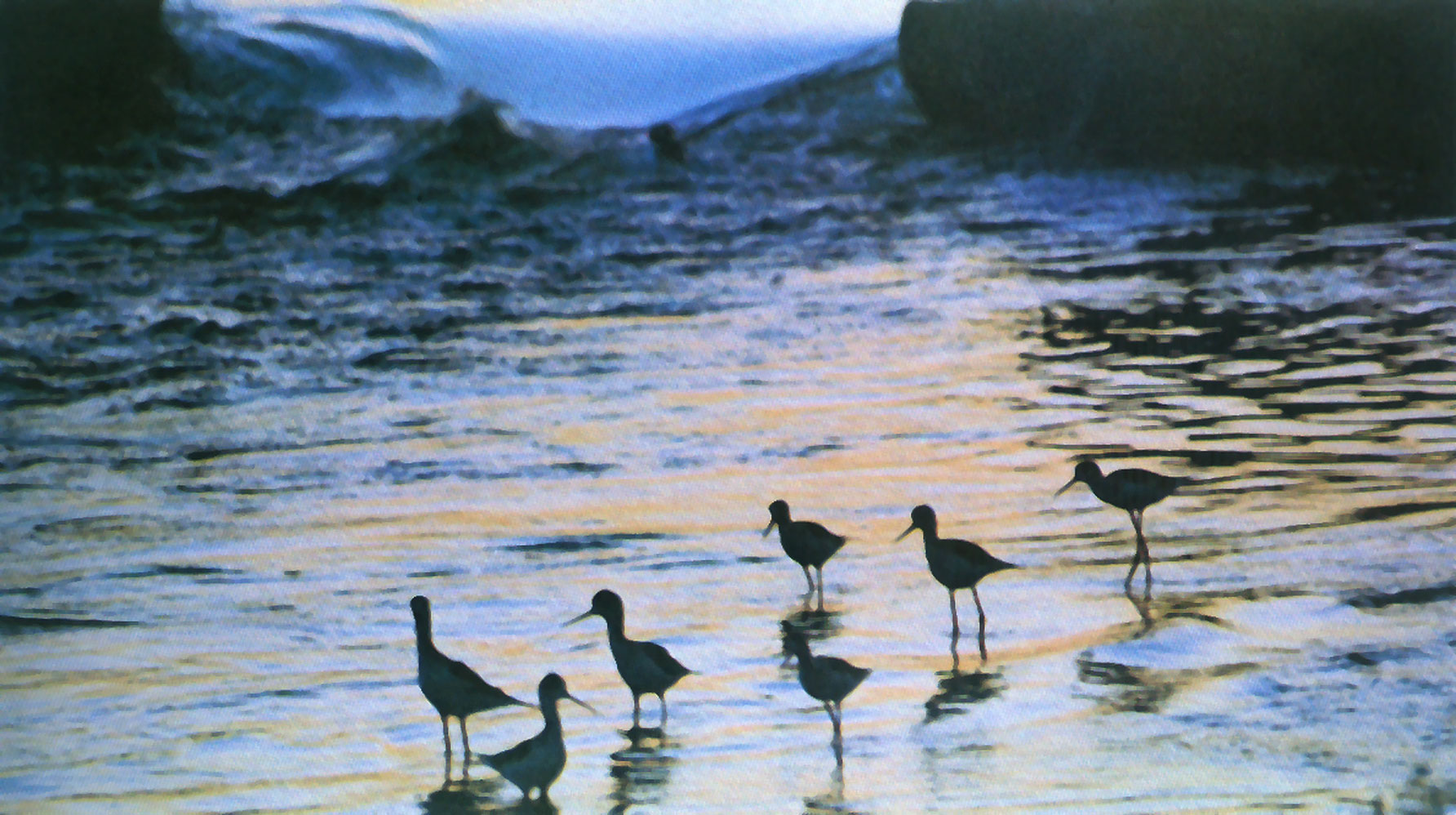
Stilts are often seen lined up across the current, facing upstream, waiting to make quick stabs at their prey as the waters flow by.
Stilt nesting nearly always occurs near water, on small islands or on boggy shores inaccessible to most predators. They form loose nesting colonies usually evenly spaced out suggesting territoriality. Open areas, near water allowing all-round visibility are favoured. Both sexes of stilts help in the nest-building process, gathering together whatever material is handy. Pebbles and shell fragments from previous nesters are accumulated in small saucer-shaped platforms of plant-stems into which the female stilt normally lays four eggs at a time, over a period of four days though she may occasionally skip a day or two in between. The eggs are peg-top shaped, yellow and olive. Ideally camouflaged, they are then incubated for a period of 22-26 days with both parents sharing the responsibility by changing places every hour or so. The chicks are grey on the back and white below with bold black mid-dorsal lines or patches. They are independent from the start, remain in the nest for no longer than 24 hours and begin their explorations even before they are completely dry. They also feed by themselves and are in fact, never fed by their parents.
During the warmer hours of the day stilts settle briefly on the shore or in shallow water and may be seen standing on one leg with their heads comfortably tucked beneath a wing as they take a short nap. Even during this siesta, however, they remain alert enough to detect any form of approaching danger. Any unusual sound, or the flutter of wings is enough to alarm the birds. Calling out to each other in a shrill `pip-pip' they nod briskly, bobbing their heads up and down to signal to the others of approaching danger -- perhaps a Marsh harrier in the sky or a human too close to the water's edge. In an instant the birds are out of the water, long legs dangling and dripping, and are airborne in search of a new, safe place to settle.
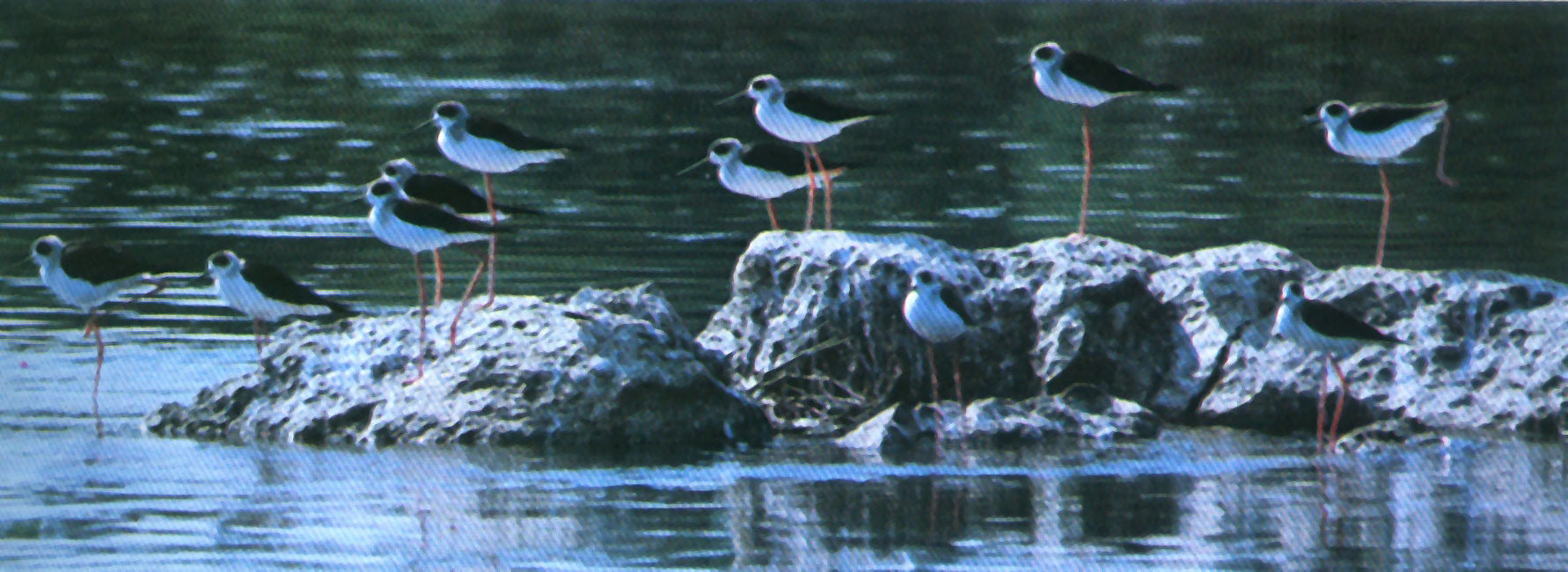
During the warmer hours of the day, stilts may settle on rocks or in the shallows with one leg raised, to take a brief siesta from their feeding activities.
Come summer and several stilts may begin pairing off to establish a more permanent bond. The pair may hunt together and follow each other pipping continuously and, just prior to their northward migration in April/May, huge flocks of these gregarious birds can now be seen in the sky flying in loose formation as if preparing for their long journey north. The habitat of the stilt was at one time so extensive, and the birds so abundant that one could never imagine that man could ever pose a threat to this delicate bird. Today, however, a burgeoning population, urbanisation and its corollary -- industrial pollution, all contribute towards seriously damaging and encroaching upon the habitat of the Black-winged stilt. Until sufficient protection is afforded to the waterbodies in our country to ensure the safety of this bird's habitat, the number of stilts, and other waders too, is bound to diminish. Conservation should not solely be aimed at saving rare bird species like the crane or the bustard, but widened to encompass the protection of the more common species as well. Unless this is done we will ultimately be forced to place the `common' stilt on the endangered list as well. And what a sad day that would be.
First Published in Sanctuary Asia Vol. IV No. 3, July/September 1984







